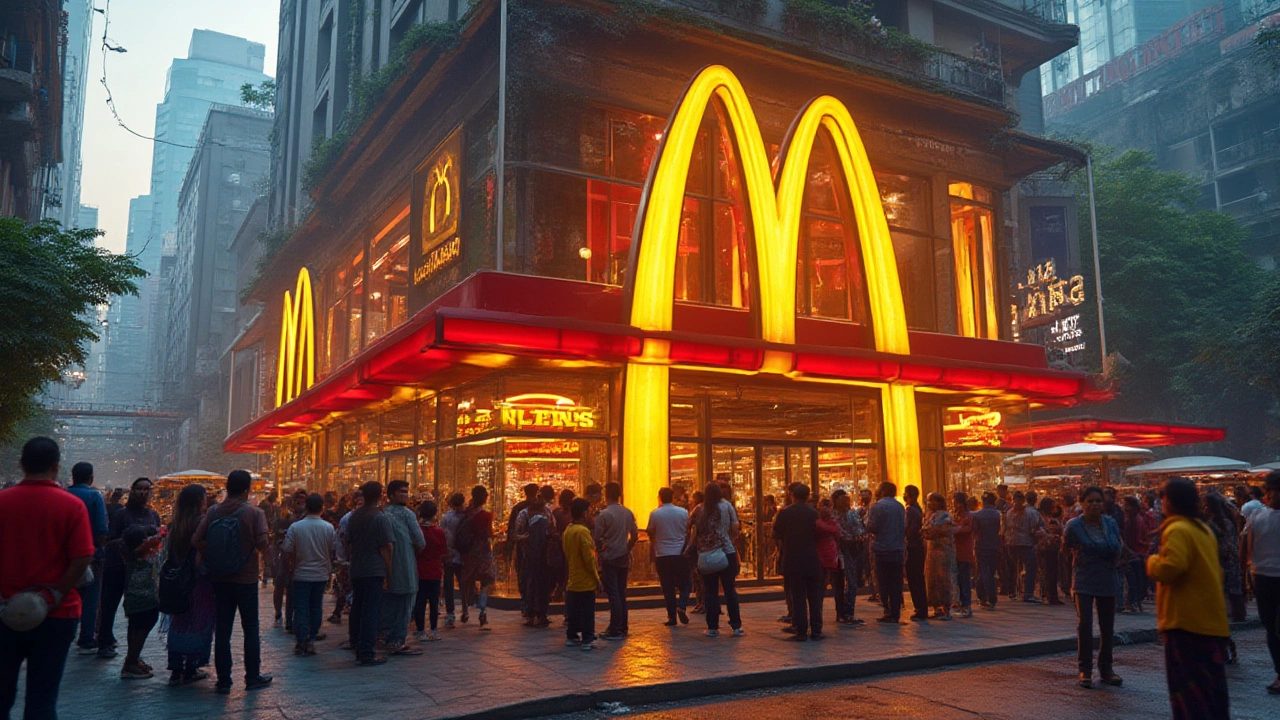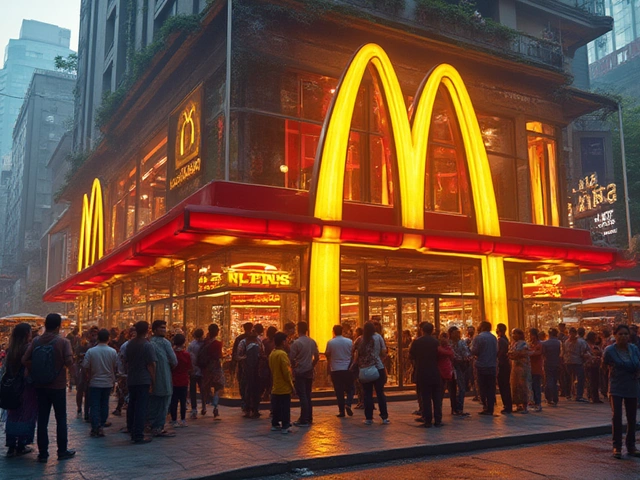Trying to open your own McDonald's in India? You're probably wondering what's really underneath the golden arches besides those fries. The price tag to get your own McDonald's is bigger than you’d guess, but there’s a good reason why the world’s most famous burger chain carries such a hefty investment in 2025. Not everyone who wants one actually gets to flip burgers for the big M – it’s a strict process. Yet, the payout can be fantastic if you crack the code. The journey isn’t just about cash, though; it’s about navigating rules, competition, and a fast food industry that moves at full throttle. Here’s a seat at the table for a no-fluff, all-details breakdown of McDonald's franchise cost in India today.
The Real Cost Breakdown of a McDonald's Franchise in India
Let’s get right to the meat of the deal. McDonald’s isn’t shy about charging a premium. The total capital requirement to set up a single McDonald’s franchise in India ranges from ₹6.5 crore to ₹15 crore. Yes, that’s crores, not lakhs. This range covers everything: land (if it's not leased), construction, interiors, kitchen equipment, signage, IT systems, training, and working capital to ride out those slow days.
If you’re eyeing a city-center outlet (those massive, two-storey spaces with tons of foot traffic), you’re realistically looking at the upper end of this range, possibly more. Smaller outlets or McDonald’s Express (set up in food courts or highways) can skew towards the lower end. Now, McDonald’s isn’t a property dealer — they don’t sell you the land. You’re expected to either own or lease it long-term. Rarely does McDonald’s buy prime land for franchisees now; they’ve gotten stricter post-pandemic, preferring long leases at prominent locations.
Here’s a transparent breakdown of major initial costs as of 2025:
| Investment Head | Estimated Cost (₹) |
|---|---|
| Franchise Fee (One-Time) | 30 lakhs to 45 lakhs |
| Interior & Kitchen Setup | 3.5 crore to 7 crore |
| Equipment & Signage | 1 crore to 2 crore |
| Initial Inventory | 12 lakh to 20 lakh |
| Training | 3 lakh to 7 lakh |
| Working Capital (6 months) | 15 lakh to 35 lakh |
The franchise fee itself – paid to McDonald's just for the brand and rights – is fixed, but almost all other costs depend on city, shop size, and whether it's a full-service or McCafé variant. Here’s a curveball – McDonald’s in India doesn’t franchise on a first-come-first-serve basis. They segment the country regionally. For example, Hardcastle Restaurants (West & South India) and Connaught Plaza Restaurants (North & East India) own regional franchise rights and sub-franchise to partners. This means, if you want in, you approach these master franchisees, not McDonald’s HQ directly.
Don’t forget the recurring fees after you’re open. You’ll pay 4-5% of your gross monthly sales as a royalty, plus another 4% for advertising, both non-negotiable. You can’t sneak around these with creative accounting — McDonald’s does monthly audits and is known for strict financial checks.
How Profitable Is a McDonald’s Franchise in India?
Okay, so you’ve plonked down several crores, navigated all the red tape, finally opened your shiny new store, and now the million-rupee question: does a McDonald’s franchise in India actually make money? Most franchise owners will never say it in public, but sources close to the industry peg annual net profits (after all expenses) at roughly ₹45 lakh to ₹90 lakh for a standard, high-traffic outlet. Some of the bigger, busiest branches bring in more than ₹1 crore in net profit every year, while smaller locations might struggle to break ₹30 lakh.
Margins in Indian fast food haven’t kept pace with inflation, but McDonald’s still draws crowds. Here’s how the money works: average monthly sales range from ₹30 lakh (small outlet) to ₹1 crore (large flagship store), depending on location and city. After paying rent, staff salaries, supply chain costs (which are tightly controlled by McDonald’s, meaning you can’t cheap out with other suppliers), utilities, franchise fees, and advertising, what’s left is usually 10% to 20% of gross sales. Here’s a typical math:
| Sales/Cost Item | Small Outlet (₹/month) | Large Outlet (₹/month) |
|---|---|---|
| Gross Sales | 35 lakh | 90 lakh |
| COGS (food cost) | 15 lakh | 36 lakh |
| Rent | 4 lakh | 12 lakh |
| Salaries | 5 lakh | 10 lakh |
| Royalty (5%) | 1.75 lakh | 4.5 lakh |
| Advertising (4%) | 1.4 lakh | 3.6 lakh |
| Utilities/Misc | 2 lakh | 3 lakh |
| Net Profit | 5 lakh | 20 lakh |
This example assumes your outlet is doing average to solid business. It can swing way lower if your spot is in a newly-developing area or if the mall you're in pulls less crowd. One big tip: drive-thrus and highway outlets see higher revenue per store than most in-mall spots! Also, McCafé sales are what really spike margins for some franchisees—especially locations in Mumbai and Delhi, where Indians are finally warming up to coffee.
Yet, you should know that it usually takes 3-4 years to break even. That’s because of the huge upfront costs. Most franchisees in India report that after hitting the sweet spot with steady footfall, profits scale fast, but the journey isn’t effortless. Success depends way more on location selection and management skills than on just the brand name. Want to play it safe? Some franchisees own more than one McDonald’s, using profits from their first outlet to help fund the second and spread out risk.

Franchise Application Process and Requirements
Buying into a McDonald's franchise India setup is not as easy as just showing up with a briefcase of cash. There’s an actual selection process and a waiting list. McDonald’s hunts for applicants who are financially stable – meaning you’ve got proof of net worth of at least ₹10 crore and can cough up 25-40% of the total investment as liquid funds (not loans). They want operational experience too. A food services or retail background isn’t mandatory, but it’s a big plus. To weed out passive investors, McDonald’s favors people ready to handle daily operations themselves – or very close family, no faceless investment groups allowed.
The application process in 2025 breaks down like this:
- Initial Registration: Fill out a detailed application on the regional franchisee's portal (Hardcastle or Connaught Plaza, depending on state). You'll answer questions about assets, relevant business experience, and motivation for getting into McDonald's.
- Screening: If your profile matches the basic requirements, there’s an interview round. They want to check your business sense, communication skills, and attitude toward running a middle-management-intensive business.
- Site Selection: If they like you, the company’s location acquisition team works with you to scout possible sites. You don’t always have a choice – McDonald’s can recommend strategic spots they believe fit their network plan.
- Business Plan & Approval: You’ll develop an operational plan, growth vision, and forecast cash flows, which is reviewed. If it’s solid, the next step is a chain of background checks and franchisee training at an existing store, lasting around 9-12 months.
- Agreement Signing & Store Opening: Once you’re in, contracts are signed, you pay up the fees, get access to designs, start the build, and finally open.
One thing that scares off a lot of people? The time frame. From first registration to grand opening, it’s pretty normal for the whole process to take 18 to 24 months. This isn’t for someone who wants in and out fast. A smart move many applicants make: scope out locations in tier II and tier III cities, where competition for prime spots isn’t as brutal, and setup costs are a bit kinder.
Pro tip – McDonald’s regularly runs special drives once or twice a year when they're looking to expand rapidly. Get in during these drives for a slightly faster process, but be ready to hustle.
What Else to Know About Running a McDonald’s Franchise in India
If you’re still excited about the possibilities, it helps to know what you’re really signing up for. A McDonald’s franchise is a full-time, on-your-feet business. Indian outlets are open early to late, often 7 AM to midnight in metros. Staff churn is high, and managing personalities matters just as much as managing numbers. McDonald’s expects strict adherence to systems — audits happen regularly, and standards are non-negotiable. Every recipe, cleaning timetable, and local adaptation (think: Maharaja Mac, McAloo Tikki, and the new Butter Chicken Burger for North India) follows company-approved playbooks.
There are strict supply chain controls. After COVID-19, McDonald’s relies on a network of Indian suppliers for 97% of its products – so, you can’t get potatoes or buns from that cheap source across town, no matter the deal. Training is continuous and technology-driven; from app orders to quick kitchen dashboards for cooking timelines, the back end is just as modern as any global chain. Cost-focused? You’ll have to pay for every update, from menu board tech to POS system upgrades, as it’s all standardized.
Marketing is another beast. National level campaigns are mandatory deductions from gross sales, but you also run local marketing (think: cross-promotion with shopping malls, college events, influencer gigs). Most successful franchisees say building tight community ties—like sponsoring local cricket matches or codesigning local menu items—keeps footfall high when it matters most.
A fun fact that surprises most newcomers: breakfast menus and McDelivery are now major sales drivers in India’s metros, thanks in part to the mad growth of Swiggy and Zomato. In cities like Bangalore, a third of many outlets’ monthly sales come from delivery apps. The catch? App orders carry extra commission charges, but the total sales volume more than make up for it.
And finally, there’s future-proofing. As of 2025, McDonald’s is piloting plant-based burgers in select Indian stores, which are expected to draw younger, eco-conscious crowds and tap into the fast-growing flexitarian market. Anyone getting in on the ground floor of new menu launches often sees a bump in orders—with new items from international menus getting local spins almost every quarter. If you want to stay one step ahead, keep your eye out for these rollouts and adapt quickly.

